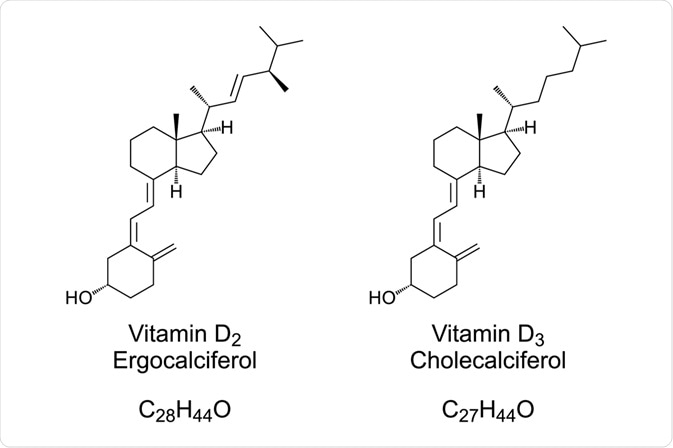Vitamin D exists in two forms, vitamin D2 and vitamin D3, which differ in the structure of their side chains that are known as ergocalciferol and cholecalciferol, respectively.

Image Credit: Peter Hermes Furian / Shutterstock.com
Both forms of vitamin D are equivalent in terms of their biological activity and dosage.
Moreover, both vitamins D2 and D3 are metabolized by their conversion to the 25-hydroxy form and then to the 1,25-dihydroxy metabolite in the kidney, which is the bioactive form of this vitamin. This metabolite has a structure that is similar to other steroid hormones produced in the body.
Source of vitamins D2 and D3
Vitamin D2 is found in a few plant sources but is mostly produced on a commercial scale by the irradiation of yeast. The type of vitamin D2 that is formed through this method is what is used to fortify foods and produce supplements.
Vitamin D3 has several sources, as it can be produced by ultraviolet radiation that is acting on the parent compound, or ingested in the form of deep-sea fatty fish, egg yolks or liver, or supplements.
Vitamin D is a derivative of 7-dehydrocholesterol, also called ergosterol. This conversion is mediated by the action of ultraviolet radiation the parent compound, which is formed in the Malpighian layer of skin during a relatively minor route of cholesterol synthesis.
Ultraviolet radiation with wavelengths between 290-315 nm causes the bond between the 9th and 10th positions of the steroid ring to open, forming a compound called secosterol. This further undergoes cis-to-trans isomerization, by the formation of a trans bond between the 5th and 6th carbon atoms, leading to the formation of vitamin D3, or cholecalciferol. The involvement of ultraviolet radiation in the process has led to vitamin D being nicknamed the “sunshine vitamin.”
Activity
Cholecalciferol, which is the side chain of vitamin D3, is then carried to the liver, where a mitochondrial hydroxylase enzyme introduces a hydroxyl group at the 25 positions. This reaction requires energy in the form of NADPH and oxygen. The product, called 25-hydroxy cholecalciferol, is the inactive storage form of cholecalciferol and is stored in the liver.
As necessary, 25-hydroxycholecalciferol is transported to the kidney, where a second hydroxylation occurs at the 1 position, converting it to 1,25-dihydroxy cholecalciferol, the bioactive form of vitamin D.
The production of this active form is regulated by an enzyme produced in the kidney, which is itself controlled by several factors. These include feedback from the level of the active form of the vitamin already in circulation, the secretion of parathyroid hormone, as well as calcium and phosphate levels which are the primary target of action of the vitamin.
1,25-dihydroxy cholecalciferol, also called calcitriol, is carried in the bloodstream to the intestinal mucosa. There, it stimulates the absorption of calcium and phosphate, the mineral ions which are of prime importance in the building up of bone and other supportive tissue. It also promotes bone growth and remodeling by osteoblasts and osteoclasts.
References
Further Reading
Last Updated: Jan 17, 2023